Quantum Computing Threat Timeline Calculator
Current Probability Estimates
Based on Global Risk Institute (GRI) projections:
- 2034: 17-34% chance
- 2035: ~45% chance
- 2040: 60-75% chance
- 2044: 79% chance
- 2050+: >90% chance
Regulatory Deadlines
- NSM-10 (2035): Full post-quantum migration required
- DHS (2030): Aggressive timeline for federal agencies
- CNSA 2.0 (2025): PQC preferred immediately
- EU Quantum-Ready (2032): Compliance for critical infrastructure
Your Risk Assessment
Estimate your organization's quantum threat exposure:
Risk Assessment Results
Enter your selections and click "Calculate Risk Exposure" to see your organization's quantum threat assessment.
Organizations are scrambling to answer a single question: quantum computing threat - when will it turn current encryption into an open diary? The answer lives in a rapidly evolving timeline that blends expert probability estimates, government mandates, and hard‑wired hardware breakthroughs. Below you’ll find the latest numbers, the regulatory clocks ticking in the background, and a practical to‑do list for anyone responsible for protecting data today.
TL;DR - Quick Takeaways
- Global Risk Institute (GRI) puts a 17‑34% chance of a CRQC breaking RSA‑2048 by 2034; that jumps to ~79% by 2044.
- U.S. federal mandates require full post‑quantum migration by 2035 (NSM‑10) and as early as 2030 for some agencies (DHS).
- Technical milestones - error‑corrected logical qubits and quantum volume growth suggest a plausible break point between 2035‑2040.
- More than half of surveyed enterprises are already measuring exposure; 30% are actively piloting PQC.
- Immediate actions: inventory crypto assets, start pilot migrations using NIST‑approved algorithms, and align with upcoming compliance dates.
How the Timeline Is Built - Sources and Methodology
Three pillars shape the current timeline:
- Expert probability models (e.g., the Global Risk Institute a research group that aggregates forecasts from quantum physicists, cryptographers, and industry leaders 2024 report).
- Governmental deadline frameworks (e.g., National Security Memorandum 10 (NSM‑10) mandates full post‑quantum migration for federal systems by 2035).
- Technical trajectory assessments (e.g., MITRE the defense agency that publishes annual quantum readiness forecasts 2025 evaluation).
Each source uses a different lens - probability, policy, or hardware progress - but they converge on a 5‑15‑year window for a Cryptographically Relevant Quantum Computer (CRQC) a quantum system large enough to run Shor's algorithm against RSA‑2048 within 24hours. By aggregating these views, we get a composite timeline that’s both realistic and actionable.
Probability Milestones - When Might RSA‑2048 Fall?
| Year | Probability (%) | Key Drivers |
|---|---|---|
| 2030 | 5-12 | Early logical‑qubit scaling, error‑correction prototypes |
| 2034 | 17-34 | GRI consensus, quantum volume >400, multi‑module integration |
| 2035 | ~45 | First generation fault‑tolerant processors, commercial cloud offerings |
| 2040 | 60-75 | Full‑stack error correction, >1,000 logical qubits |
| 2044 | 79 | MITRE high‑confidence scenario, hardware‑software co‑design breakthroughs |
| 2050+ | >90 | Widespread commercial availability, cost per logical qubit drops dramatically |
Note that probabilities are not linear - they reflect exponential hardware improvements observed over the past decade. The most aggressive expert surveys (e.g., SANS 2025) argue that a break point could appear as early as 2029 if error‑correction yields reach the logical‑qubit threshold faster than projected.
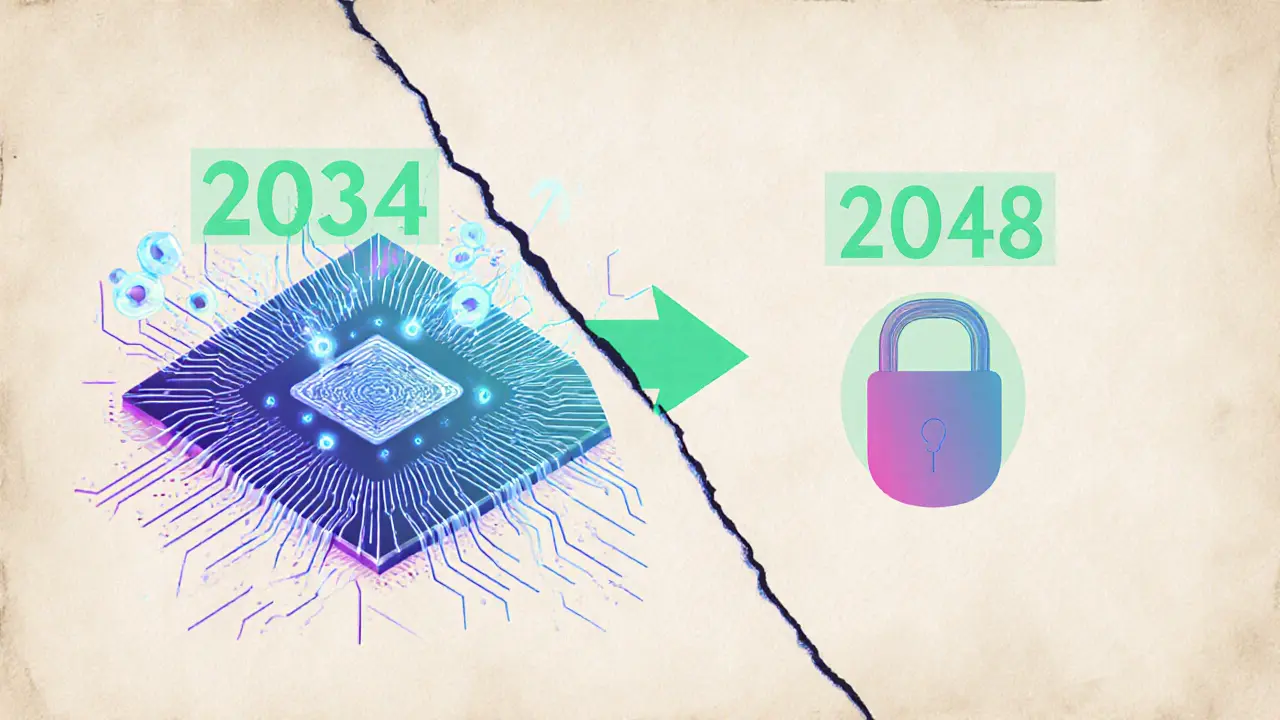
Regulatory Deadlines - What the Law Is Saying
Governments have stopped waiting for “the worst‑case scenario” and are imposing concrete dates:
- National Security Memorandum 10 (NSM‑10) - all federal systems must be quantum‑safe by 2035.
- Department of Homeland Security (DHS) requires agencies to complete migration by 2030 - the most aggressive U.S. timeline.
- Commercial National Security Algorithm Suite 2.0 (CNSA2.0) declares PQC preferred immediately (2025) and mandatory for selected workloads between 2030‑2033.
- European Union’s Quantum‑Ready directive (draft 2025) targets full compliance for critical infrastructure by the end of 2032.
These mandates assume a realistic risk horizon of 5‑15 years, meaning most enterprises must start migration now rather than waiting for the “final” quantum computer.
Technical Progress - Quantum Hardware Milestones
Two technical trends are reshaping the timeline:
- Error‑Correction Breakthroughs - In 2024, researchers demonstrated a logical qubit with error rates below 0.1% using surface‑code techniques. That level of suppression is the missing piece for scaling to the ~1,000 logical qubits needed for RSA‑2048 attacks.
- Quantum Volume Growth - The industry metric now sits above 1,000 for leading platforms (IBM, Google, Rigetti). Higher volume directly translates to more reliable multi‑gate circuits, a prerequisite for Shor’s algorithm.
When you combine these advances with accelerating chip‑fabrication pipelines (silicon‑photonic integration, cryogenic control electronics), the traditional linear projection used by MITRE (2025) shifts toward an exponential curve. That’s why the GRI report upgraded the 2034 probability range from 5-15% (2022) to 17-34% (2024).
Industry Readiness - How Companies Are Responding
Survey data tells a clear story:
- Deloitte Global Future of Cyber survey found 52% of firms are currently measuring quantum exposure.
- 30% have begun pilot projects with NIST‑approved algorithms such as CRYSTALS‑KYBER (key‑encapsulation) and CRYSTALS‑DILITHIUM (digital signatures).
- Financial institutions report universal awareness of the threat - executives cite the 2024 NIST PQC standards as the primary decision catalyst.
That readiness varies by sector. Critical‑infrastructure owners tend to align with DHS deadlines, while SaaS providers often opt for a phased approach, swapping out only high‑value APIs first.
What You Should Do Right Now - Action Checklist
Regardless of industry, the following steps keep you ahead of the curve:
- Map every cryptographic asset. Identify where RSA‑2048, ECC, or AES are used - in transit, at rest, or within digital signatures.
- Prioritize data based on shelf‑life. Records with a 10‑year retention window (e.g., credit‑card data) are high‑risk for “harvest‑now, decrypt‑later” attacks.
- Run a risk‑scoring model. Plug in GRI probability curves to estimate exposure for each asset class.
- Start pilot migrations. Deploy NIST‑approved PQC (CRYSTALS‑KYBER, NTRU, SPHINCS+) on non‑critical services.
- Engage compliance owners. Align your roadmap with NSM‑10, DHS, and EU deadlines to avoid regulatory penalties.
- Monitor hardware milestones. Track logical‑qubit counts, error‑correction thresholds, and quantum‑volume reports from major providers.
- Plan for hybrid cryptography. Until PQC is ubiquitous, use layered approaches - e.g., RSA‑2048 + 256‑bit AES + PQC‑enabled key exchange.
By treating quantum readiness as a continuous risk program instead of a one‑off project, you’ll avoid costly re‑architectures when the next breakthrough hits.
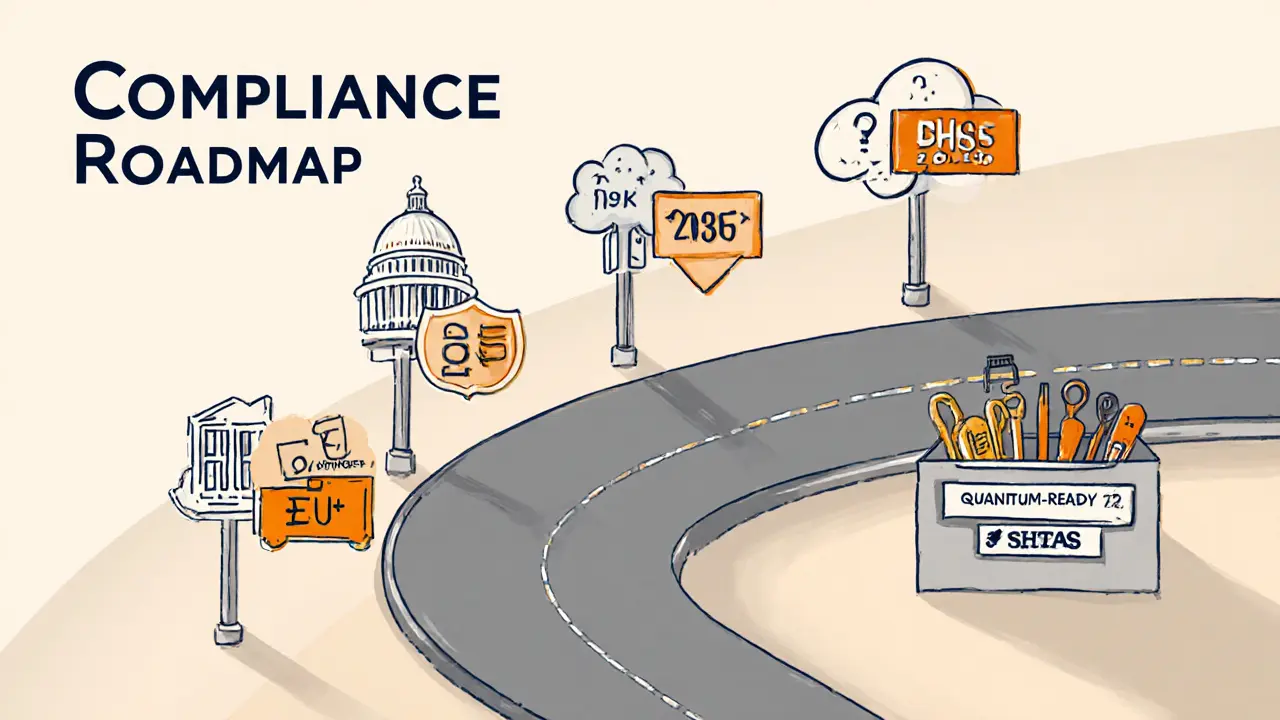
Frequently Asked Questions
When is the earliest realistic date a quantum computer could break RSA‑2048?
The most credible expert forecasts, such as the Global Risk Institute 2024 report, place a 17‑34% chance of a break by 2034. Some aggressive models argue for a possible break as early as 2029 if error‑correction scales faster than expected.
Do AES‑256 keys need to be replaced now?
AES‑256 is only vulnerable to Grover’s algorithm, which offers a quadratic speed‑up. Doubling the key length (e.g., to AES‑512) restores the security margin, but most experts recommend migrating to PQC‑compatible modes rather than relying on larger symmetric keys alone.
What are the NIST‑approved post‑quantum algorithms?
The 2024 NIST standardization round finalized four algorithms: CRYSTALS‑KYBER (KEM), CRYSTALS‑DILITHIUM (signature), FALCON (signature), and SPHINCS+ (signature). These are ready for implementation today.
How can I estimate the cost of a quantum‑safe migration?
Start by cataloguing all crypto‑dependent assets, then apply a per‑instance cost model (software licensing, development hours, testing). Add a 20‑30% buffer for compliance testing and future algorithm updates. Most midsize firms see a $200K‑$500K upfront investment, but spreading it over five years aligns with typical budget cycles.
Should I wait for a universal quantum‑safe standard before acting?
No. The 2024 NIST standards are already authoritative, and many vendors offer libraries today. Early adoption reduces technical debt and positions your organization to meet NSM‑10 and DHS deadlines comfortably.
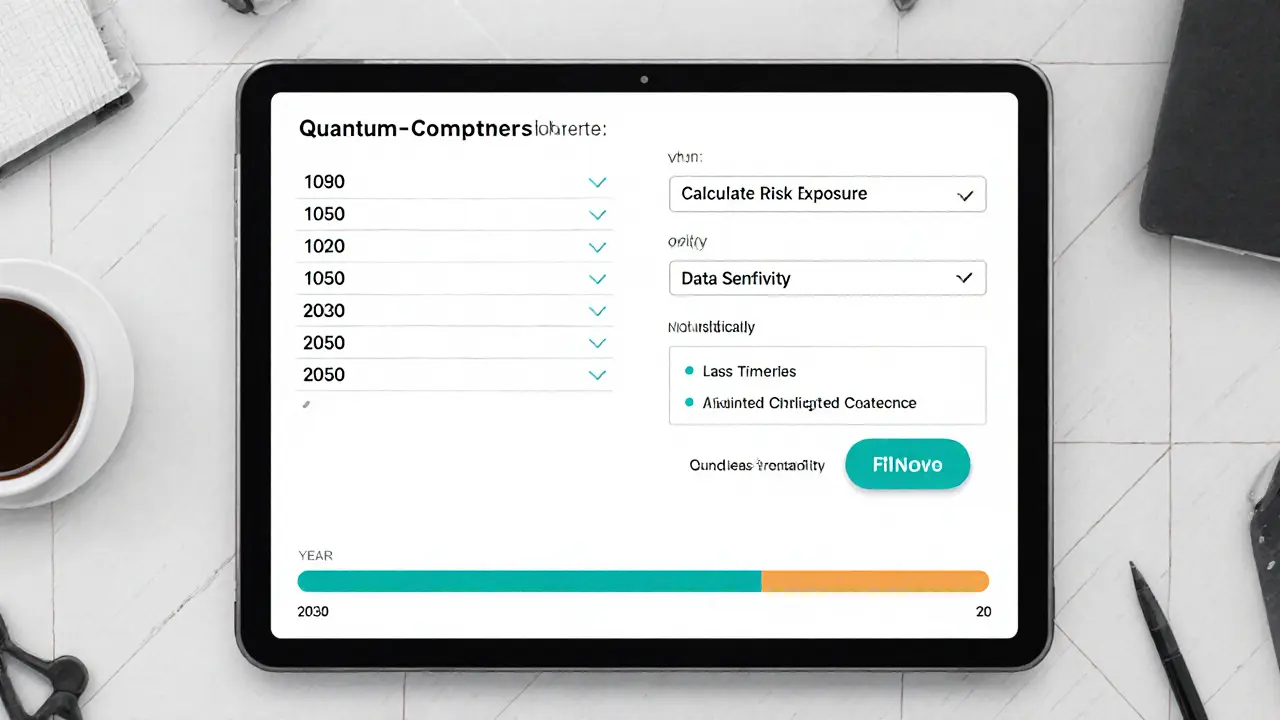

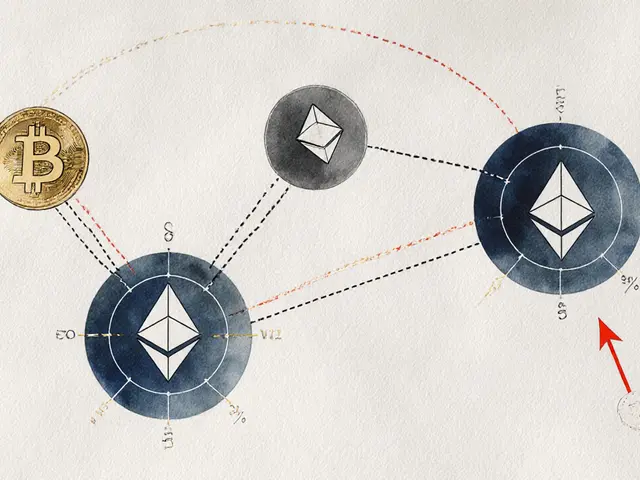

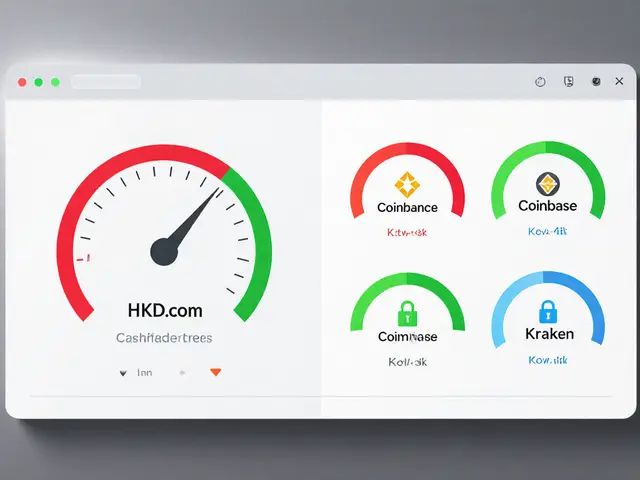
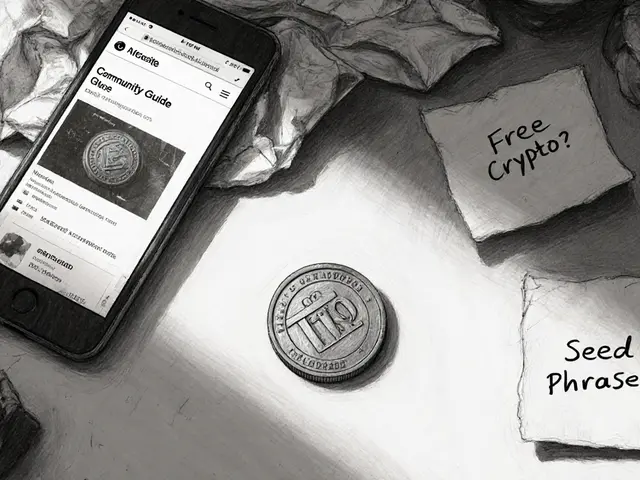
Sumedha Nag
22 June, 2025 . 12:10 PM
Honestly, I think everybody’s freaking out way too early. The whole quantum panic vibe feels like a hype train that’s already left the station, and we’re just clinging to the rail hoping for a seat. Sure, the probabilities are climbing, but the hardware curve has a way longer tail than most analysts admit. Remember how we all thought AI would take over by 2020? Same pattern. If you look at the current error‑correction rates, they’re still in the single‑digit percentages, nowhere near the sub‑0.1% needed for a reliable CRQC. So, while the reports throw 45% at 2035, the reality is that we’re still in the research lab stage, not the production stage. Let’s keep an eye on the milestones, but not lose sleep over them just yet.
Holly Harrar
28 June, 2025 . 19:27 PM
Hey folks, great rundown! just a quick heads‑up – don’t forget to check out NIST’s latest pqc guidelines, they’re super useful. also, start mapping your rsa‑2048 assets now, it’ll save you a ton of headache later. the timeline looks scary but you can totally start pilot projects this yr – try out kyber for key exchange and dilithium for sigs. it’s not rocket science, just some solid planning. good luck!
Alex Yepes
5 July, 2025 . 02:44 AM
The presented timeline is a convergence of three independent modalities: probabilistic forecasting, statutory imperatives, and empirical quantum hardware benchmarks. Each modality contributes a conditional probability distribution that, when aggregated via Bayesian fusion, yields a posterior estimate of quantum readiness. The Global Risk Institute’s 17‑34% figure for 2034 is derived from a Monte‑Carlo simulation of qubit error‑rate decay, assuming a geometric improvement factor of 1.73 per annum. Concurrently, the National Security Memorandum 10 imposes a deterministic constraint that mandates migration irrespective of probabilistic certainty, thereby elevating the risk exposure function. From a cryptographic standpoint, the vulnerability surface expands non‑linearly as the quantum volume surpasses the threshold of 400 logical qubits, a phenomenon substantiated by recent publications from MIT and IBM. The error‑correction overhead, presently measured at a physical‑to‑logical qubit ratio of approximately 10^3, must be reduced to below 10^2 before RSA‑2048 becomes practically breakable. Moreover, the quantum‑volume growth curve exhibits an exponential trend with a doubling period of roughly 1.8 years, accelerating the timeline beyond linear extrapolations. The regulatory calendars, including the DHS 2030 deadline, act as hard constraints that supersede stochastic forecasts, effectively compressing the decision window for enterprises. Therefore, a prudent risk mitigation strategy should integrate both the stochastic forecasts and the deterministic regulatory milestones, employing a hybrid cryptographic architecture that layers post‑quantum key exchange with conventional RSA. In practice, this entails deploying NIST‑approved algorithms such as CRYSTALS‑KYBER alongside existing PKI frameworks, thereby preserving interoperability while enhancing post‑quantum resilience. Finally, ongoing monitoring of logical qubit counts and error‑rate metrics is essential, as deviations from the projected hardware trajectory can materially alter the probability distributions and, consequently, the optimal migration timeline.
Bianca Giagante
11 July, 2025 . 10:00 AM
Wow-what a comprehensive overview!; the data points are fascinating,; the regulatory deadlines are especially critical; and the technical progress is truly accelerating. It’s clear that we can’t afford to sit on the sidelines-every organization must act now.
Andrew Else
17 July, 2025 . 17:17 PM
Oh great, another panic about quantum doom.
Susan Brindle Kerr
24 July, 2025 . 00:34 AM
This is the most dramatic thing I have read all day. The world is on the brink and we must act like heroes. Everyone should drop what they’re doing and start migrating to post‑quantum right now. No one can be too safe. This is not a drill, it’s a call to arms. The future belongs to the prepared.
Jared Carline
30 July, 2025 . 07:50 AM
While the data presented appears thorough, I must question the underlying assumptions regarding error‑correction scalability. It seems overly optimistic to extrapolate current trends linearly without accounting for fundamental physical limits. Moreover, the regulatory mandates appear to prioritize political expediency over technical feasibility. One ought to adopt a measured approach, balancing urgency with realistic assessments of hardware progress.
raghavan veera
5 August, 2025 . 15:07 PM
The timeline reminds us that technology is not just a sequence of numbers but a philosophical journey. Each breakthrough forces us to reconsider what it means to secure information, to trust a system, even to trust ourselves. As we edge closer to breaking RSA‑2048, we must also reflect on the impermanence of all constructs we deem safe.
Danielle Thompson
11 August, 2025 . 22:24 PM
Great summary! Keep pushing forward 🚀
Eric Levesque
18 August, 2025 . 05:40 AM
If they want to rush this, let them. The US will stay ahead, no doubt.
alex demaisip
24 August, 2025 . 12:57 PM
From a cryptanalytic perspective, the convergence of quantum volume trajectories with NIST's post‑quantum standardization pipeline introduces a multi‑dimensional risk surface. The stochastic modeling employed by GRI leverages a Poisson‑biased estimator to account for hardware uncertainty, resulting in a confidence interval that aligns with the observed error‑correction supremacy milestones. Practically, enterprises should adopt a hybrid cryptographic stack, integrating both classical RSA‑2048 buffers and CRYSTALS‑KYBER KEMs, thereby mitigating the emergent threat vector while preserving backward compatibility. In light of the upcoming NSM‑10 mandate, a phased migration strategy-prioritizing high‑value assets-will optimize resource allocation and regulatory compliance.
Elmer Detres
30 August, 2025 . 20:14 PM
Nice points, Raghavan! 🌟 It’s true that the philosophical side matters, but we also need concrete steps. Start by inventorying your crypto, then pilot a hybrid setup. You’ll thank yourself later.
Tony Young
6 September, 2025 . 03:30 AM
Wow, this is a game‑changer! 🎉 The timeline really drives home how urgent the migration is. I’m already pushing my team to start testing Kyber in our key exchange flows. Let’s not wait for the break‑the‑code moment – act now, folks! 🚀
Fiona Padrutt
12 September, 2025 . 10:47 AM
Look, we’ve got to stay ahead of the curve. The US can’t afford to lag on encryption standards. Get those post‑quantum upgrades in place – no excuses.
Briana Holtsnider
18 September, 2025 . 18:04 PM
This whole post‑quantum hysteria is just a buzzword circus. Most companies will never need to change anything.
Corrie Moxon
25 September, 2025 . 01:20 AM
Appreciate all the insights shared here. Let’s keep supporting each other as we navigate this transition. Together we’ll get through it!